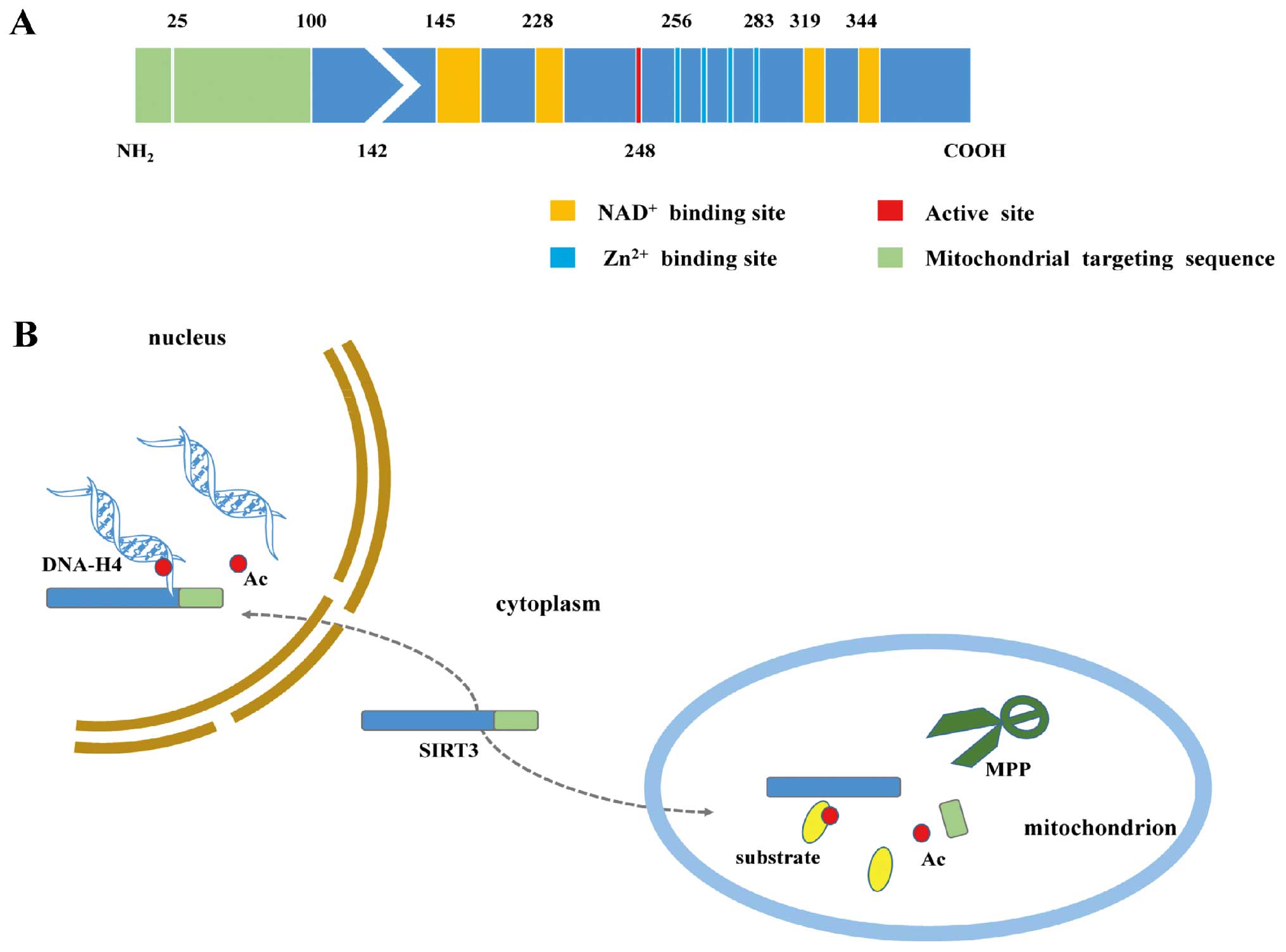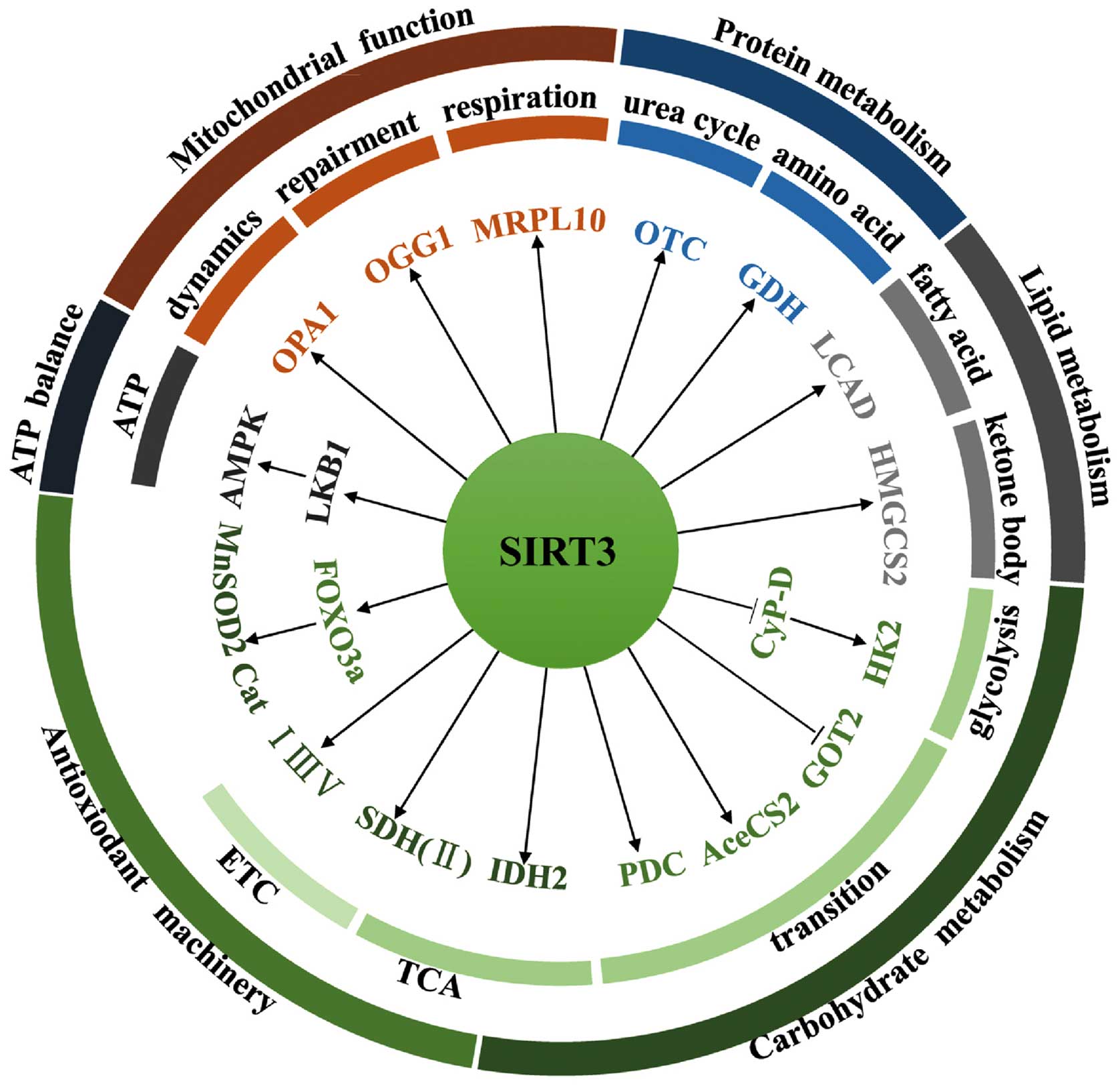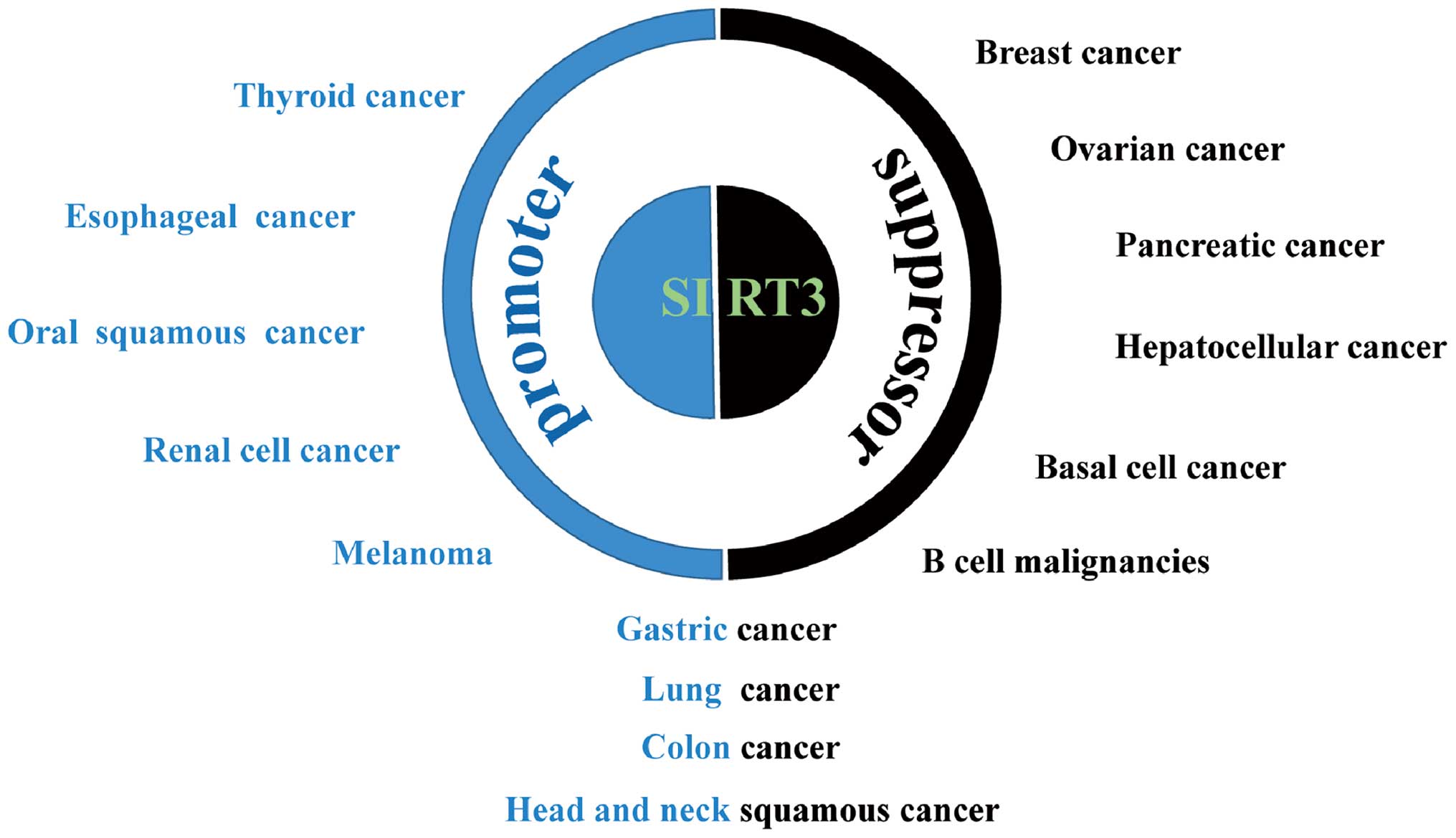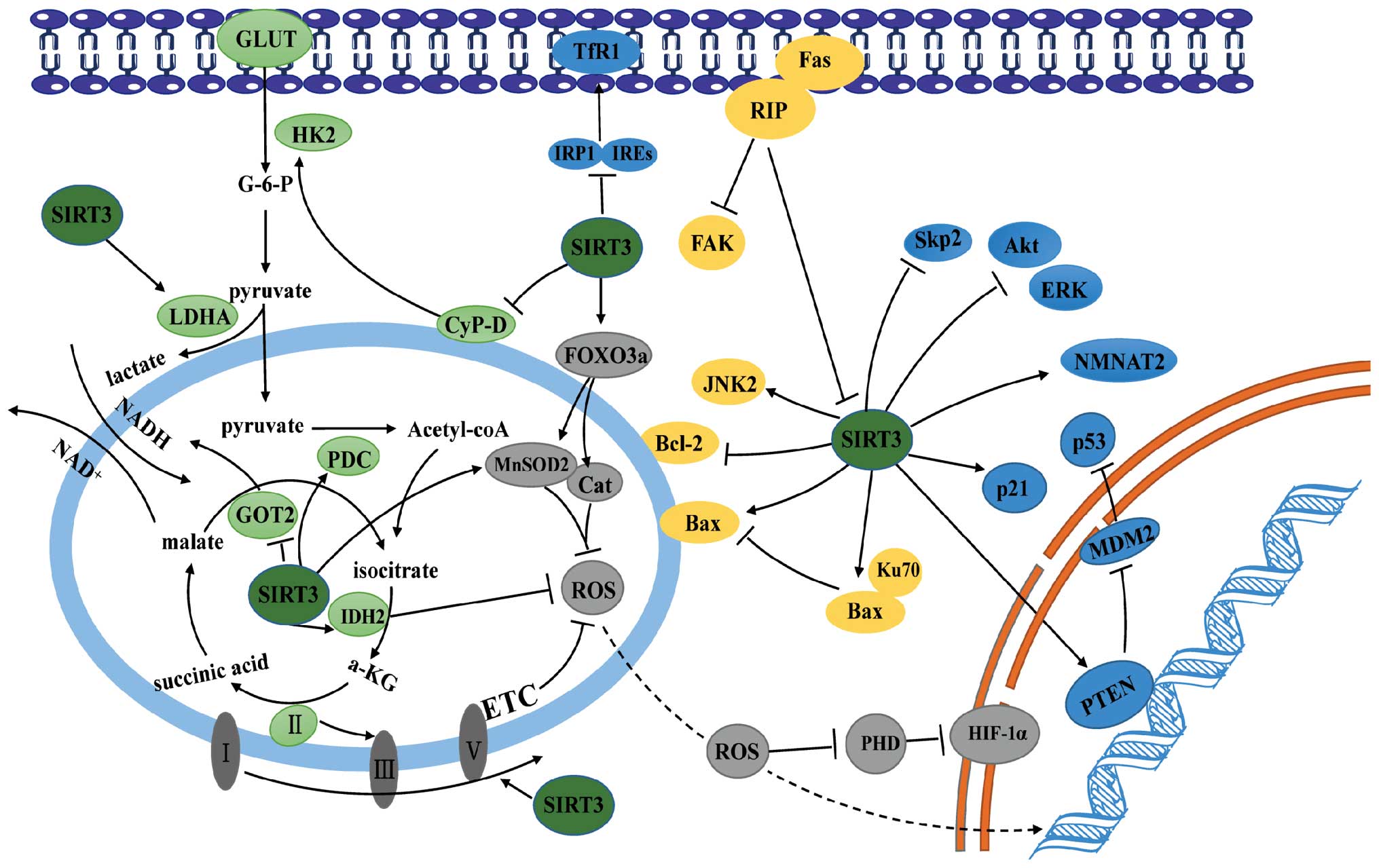Sirtuin 3: A Janus face in cancer (Review)
- Authors:
- Yanlu Xiong
- Mingxing Wang
- Jinbo Zhao
- Yong Han
- Lintao Jia
-
Affiliations: Department of Thoracic Surgery, Tangdu Hospital, Fourth Military Medical University, Xi'an, Shaanxi 710038, P.R. China, State Key Laboratory of Cancer Biology, Department of Biochemistry and Molecular Biology, Fourth Military Medical University, Xi'an, Shaanxi 710032, P.R. China - Published online on: November 10, 2016 https://doi.org/10.3892/ijo.2016.3767
- Pages: 2227-2235
This article is mentioned in:
Abstract
 |
 |
 |
 |
|
Jemal A, Bray F, Center MM, Ferlay J, Ward E and Forman D: Global cancer statistics. CA Cancer J Clin. 61:69–90. 2011. View Article : Google Scholar : PubMed/NCBI | |
|
Hanahan D and Weinberg RA: Hallmarks of cancer: The next generation. Cell. 144:646–674. 2011. View Article : Google Scholar : PubMed/NCBI | |
|
Choudhary C, Kumar C, Gnad F, Nielsen ML, Rehman M, Walther TC, Olsen JV and Mann M: Lysine acetylation targets protein complexes and co-regulates major cellular functions. Science. 325:834–840. 2009. View Article : Google Scholar : PubMed/NCBI | |
|
Kim SC, Sprung R, Chen Y, Xu Y, Ball H, Pei J, Cheng T, Kho Y, Xiao H, Xiao L, et al: Substrate and functional diversity of lysine acetylation revealed by a proteomics survey. Mol Cell. 23:607–618. 2006. View Article : Google Scholar : PubMed/NCBI | |
|
Guan KL and Xiong Y: Regulation of intermediary metabolism by protein acetylation. Trends Biochem Sci. 36:108–116. 2011. View Article : Google Scholar : | |
|
Frye RA: Phylogenetic classification of prokaryotic and eukaryotic Sir2-like proteins. Biochem Biophys Res Commun. 273:793–798. 2000. View Article : Google Scholar : PubMed/NCBI | |
|
Haigis MC and Guarente LP: Mammalian sirtuins - emerging roles in physiology, aging, and calorie restriction. Genes Dev. 20:2913–2921. 2006. View Article : Google Scholar : PubMed/NCBI | |
|
Weir HJ, Lane JD and Balthasar N: SIRT3: A central regulator of mitochondrial adaptation in health and disease. Genes Cancer. 4:118–124. 2013. View Article : Google Scholar : PubMed/NCBI | |
|
Hallows WC, Albaugh BN and Denu JM: Where in the cell is SIRT3? - functional localization of an NAD+-dependent protein deacetylase. Biochem J. 411:e11–e13. 2008. View Article : Google Scholar : PubMed/NCBI | |
|
Jing E, Emanuelli B, Hirschey MD, Boucher J, Lee KY, Lombard D, Verdin EM and Kahn CR: Sirtuin-3 (Sirt3) regulates skeletal muscle metabolism and insulin signaling via altered mitochondrial oxidation and reactive oxygen species production. Proc Natl Acad Sci USA. 108:14608–14613. 2011. View Article : Google Scholar : PubMed/NCBI | |
|
Sundaresan NR, Samant SA, Pillai VB, Rajamohan SB and Gupta MP: SIRT3 is a stress-responsive deacetylase in cardiomyocytes that protects cells from stress-mediated cell death by deacetylation of Ku70. Mol Cell Biol. 28:6384–6401. 2008. View Article : Google Scholar : PubMed/NCBI | |
|
Kumar S and Lombard DB: Mitochondrial sirtuins and their relationships with metabolic disease and cancer. Antioxid Redox Signal. 22:1060–1077. 2015. View Article : Google Scholar : | |
|
Haigis MC, Deng C-X, Finley LWS, Kim H-S and Gius D: SIRT3 is a mitochondrial tumor suppressor: A scientific tale that connects aberrant cellular ROS, the Warburg effect, and carcinogenesis. Cancer Res. 72:2468–2472. 2012. View Article : Google Scholar : PubMed/NCBI | |
|
Finley LWS and Haigis MC: Metabolic regulation by SIRT3: Implications for tumorigenesis. Trends Mol Med. 18:516–523. 2012. View Article : Google Scholar : PubMed/NCBI | |
|
Alhazzazi TY, Kamarajan P, Verdin E and Kapila YL: Sirtuin-3 (SIRT3) and the hallmarks of cancer. Genes Cancer. 4:164–171. 2013. View Article : Google Scholar : PubMed/NCBI | |
|
Chen Y, Fu LL, Wen X, Wang XY, Liu J, Cheng Y and Huang J: Sirtuin-3 (SIRT3), a therapeutic target with oncogenic and tumor-suppressive function in cancer. Cell Death Dis. 5:e10472014. View Article : Google Scholar : PubMed/NCBI | |
|
Nguyen GT, Schaefer S, Gertz M, Weyand M and Steegborn C: Structures of human sirtuin 3 complexes with ADP-ribose and with carba-NAD+ and SRT1720: Binding details and inhibition mechanism. Acta Crystallogr D Biol Crystallogr. 69:1423–1432. 2013. View Article : Google Scholar : PubMed/NCBI | |
|
Jin L, Wei W, Jiang Y, Peng H, Cai J, Mao C, Dai H, Choy W, Bemis JE, Jirousek MR, et al: Crystal structures of human SIRT3 displaying substrate-induced conformational changes. J Biol Chem. 284:24394–24405. 2009. View Article : Google Scholar : PubMed/NCBI | |
|
Schwer B, North BJ, Frye RA, Ott M and Verdin E: The human silent information regulator (Sir)2 homologue hSIRT3 is a mitochondrial nicotinamide adenine dinucleotide-dependent deacetylase. J Cell Biol. 158:647–657. 2002. View Article : Google Scholar : PubMed/NCBI | |
|
Cooper HM, Huang JY, Verdin E and Spelbrink JN: A new splice variant of the mouse SIRT3 gene encodes the mitochondrial precursor protein. PLoS One. 4:e49862009. View Article : Google Scholar : PubMed/NCBI | |
|
Onyango P, Celic I, McCaffery JM, Boeke JD and Feinberg AP: SIRT3, a human SIR2 homologue, is an NAD-dependent deacetylase localized to mitochondria. Proc Natl Acad Sci USA. 99:13653–13658. 2002. View Article : Google Scholar : PubMed/NCBI | |
|
Scher MB, Vaquero A and Reinberg D: SirT3 is a nuclear NAD+-dependent histone deacetylase that translocates to the mitochondria upon cellular stress. Genes Dev. 21:920–928. 2007. View Article : Google Scholar : PubMed/NCBI | |
|
Ahn B-H, Kim H-S, Song S, Lee IH, Liu J, Vassilopoulos A, Deng CX and Finkel T: A role for the mitochondrial deacetylase Sirt3 in regulating energy homeostasis. Proc Natl Acad Sci USA. 105:14447–14452. 2008. View Article : Google Scholar : PubMed/NCBI | |
|
Wei L, Zhou Y, Dai Q, Qiao C, Zhao L, Hui H, Lu N and Guo QL: Oroxylin A induces dissociation of hexokinase II from the mitochondria and inhibits glycolysis by SIRT3-mediated deacetylation of cyclophilin D in breast carcinoma. Cell Death Dis. 4:e6012013. View Article : Google Scholar : PubMed/NCBI | |
|
Yang H, Zhou L, Shi Q, Zhao Y, Lin H, Zhang M, Zhao S, Yang Y, Ling ZQ, Guan KL, et al: SIRT3-dependent GOT2 acetylation status affects the malate-aspartate NADH shuttle activity and pancreatic tumor growth. EMBO J. 34:1110–1125. 2015. View Article : Google Scholar : PubMed/NCBI | |
|
Hallows WC, Lee S and Denu JM: Sirtuins deacetylate and activate mammalian acetyl-CoA synthetases. Proc Natl Acad Sci USA. 103:10230–10235. 2006. View Article : Google Scholar : PubMed/NCBI | |
|
Schwer B, Bunkenborg J, Verdin RO, Andersen JS and Verdin E: Reversible lysine acetylation controls the activity of the mitochondrial enzyme acetyl-CoA synthetase 2. Proc Natl Acad Sci USA. 103:10224–10229. 2006. View Article : Google Scholar : PubMed/NCBI | |
|
Shan C, Kang H-B, Elf S, Xie J, Gu TL, Aguiar M, Lonning S, Hitosugi T, Chung TW, Arellano M, et al: Tyr-94 phosphorylation inhibits pyruvate dehydrogenase phosphatase 1 and promotes tumor growth. J Biol Chem. 289:21413–21422. 2014. View Article : Google Scholar : PubMed/NCBI | |
|
Someya S, Yu W, Hallows WC, Xu J, Vann JM, Leeuwenburgh C, Tanokura M, Denu JM and Prolla TA: Sirt3 mediates reduction of oxidative damage and prevention of age-related hearing loss under caloric restriction. Cell. 143:802–812. 2010. View Article : Google Scholar : PubMed/NCBI | |
|
Cimen H, Han MJ, Yang Y, Tong Q, Koc H and Koc EC: Regulation of succinate dehydrogenase activity by SIRT3 in mammalian mitochondria. Biochemistry. 49:304–311. 2010. View Article : Google Scholar : | |
|
Finley LW, Haas W, Desquiret-Dumas V, Wallace DC, Procaccio V, Gygi SP and Haigis MC: Succinate dehydrogenase is a direct target of sirtuin 3 deacetylase activity. PLoS One. 6:e232952011. View Article : Google Scholar : PubMed/NCBI | |
|
Schlicker C, Gertz M, Papatheodorou P, Kachholz B, Becker CF and Steegborn C: Substrates and regulation mechanisms for the human mitochondrial sirtuins Sirt3 and Sirt5. J Mol Biol. 382:790–801. 2008. View Article : Google Scholar : PubMed/NCBI | |
|
Hallows WC, Yu W, Smith BC, Devries MK, Ellinger JJ, Someya S, Shortreed MR, Prolla T, Markley JL, Smith LM, et al: Sirt3 promotes the urea cycle and fatty acid oxidation during dietary restriction. Mol Cell. 41:139–149. 2011. View Article : Google Scholar : PubMed/NCBI | |
|
Hirschey MD, Shimazu T, Goetzman E, Jing E, Schwer B, Lombard DB, Grueter CA, Harris C, Biddinger S, Ilkayeva OR, et al: SIRT3 regulates mitochondrial fatty-acid oxidation by reversible enzyme deacetylation. Nature. 464:121–125. 2010. View Article : Google Scholar : PubMed/NCBI | |
|
Shimazu T, Hirschey MD, Hua L, Dittenhafer-Reed KE, Schwer B, Lombard DB, Li Y, Bunkenborg J, Alt FW, Denu JM, et al: SIRT3 deacetylates mitochondrial 3-hydroxy-3-methylglutaryl CoA synthase 2 and regulates ketone body production. Cell Metab. 12:654–661. 2010. View Article : Google Scholar : PubMed/NCBI | |
|
Sundaresan NR, Gupta M, Kim G, Rajamohan SB, Isbatan A and Gupta MP: Sirt3 blocks the cardiac hypertrophic response by augmenting Foxo3a-dependent antioxidant defense mechanisms in mice. J Clin Invest. 119:2758–2771. 2009.PubMed/NCBI | |
|
Pillai VB, Sundaresan NR, Kim G, Gupta M, Rajamohan SB, Pillai JB, Samant S, Ravindra PV, Isbatan A and Gupta MP: Exogenous NAD blocks cardiac hypertrophic response via activation of the SIRT3-LKB1-AMP-activated kinase pathway. J Biol Chem. 285:3133–3144. 2010. View Article : Google Scholar : | |
|
Cantó C, Gerhart-Hines Z, Feige JN, Lagouge M, Noriega L, Milne JC, Elliott PJ, Puigserver P and Auwerx J: AMPK regulates energy expenditure by modulating NAD+ metabolism and SIRT1 activity. Nature. 458:1056–1060. 2009. View Article : Google Scholar | |
|
Yang H, Yang T, Baur JA, Perez E, Matsui T, Carmona JJ, Lamming DW, Souza-Pinto NC, Bohr VA, Rosenzweig A, et al: Nutrient-sensitive mitochondrial NAD+ levels dictate cell survival. Cell. 130:1095–1107. 2007. View Article : Google Scholar : PubMed/NCBI | |
|
Cheng Y, Ren X, Gowda ASP, Shan Y, Zhang L, Yuan YS, Patel R, Wu H, Huber-Keener K, Yang JW, et al: Interaction of Sirt3 with OGG1 contributes to repair of mitochondrial DNA and protects from apoptotic cell death under oxidative stress. Cell Death Dis. 4:e7312013. View Article : Google Scholar : PubMed/NCBI | |
|
Yang Y, Cimen H, Han MJ, Shi T, Deng JH, Koc H, Palacios OM, Montier L, Bai Y, Tong Q, et al: NAD+-dependent deacetylase SIRT3 regulates mitochondrial protein synthesis by deacetylation of the ribosomal protein MRPL10. J Biol Chem. 285:7417–7429. 2010. View Article : Google Scholar : PubMed/NCBI | |
|
Samant SA, Zhang HJ, Hong Z, Pillai VB, Sundaresan NR, Wolfgeher D, Archer SL, Chan DC and Gupta MP: SIRT3 deacetylates and activates OPA1 to regulate mitochondrial dynamics during stress. Mol Cell Biol. 34:807–819. 2014. View Article : Google Scholar : | |
|
Shulga N and Pastorino JG: Ethanol sensitizes mitochondria to the permeability transition by inhibiting deacetylation of cyclophilin-D mediated by sirtuin-3. J Cell Sci. 123:4117–4127. 2010. View Article : Google Scholar : PubMed/NCBI | |
|
Papa L and Germain D: SirT3 regulates the mitochondrial unfolded protein response. Mol Cell Biol. 34:699–710. 2014. View Article : Google Scholar : | |
|
Yang B, Fu X, Shao L, Ding Y and Zeng D: Aberrant expression of SIRT3 is conversely correlated with the progression and prognosis of human gastric cancer. Biochem Biophys Res Commun. 443:156–160. 2014. View Article : Google Scholar | |
|
Cui Y, Qin L, Wu J, Qu X, Hou C, Sun W, Li S, Vaughan AT, Li JJ and Liu J: SIRT3 enhances glycolysis and proliferation in SIRT3-expressing gastric cancer cells. PLoS One. 10:e01298342015. View Article : Google Scholar : PubMed/NCBI | |
|
Li H, Feng Z, Wu W, Li J, Zhang J and Xia T: SIRT3 regulates cell proliferation and apoptosis related to energy metabolism in non-small cell lung cancer cells through deacetylation of NMNAT2. Int J Oncol. 43:1420–1430. 2013.PubMed/NCBI | |
|
Xiao K, Jiang J, Wang W, Cao S, Zhu L, Zeng H, Ouyang R, Zhou R and Chen P: Sirt3 is a tumor suppressor in lung adenocarcinoma cells. Oncol Rep. 30:1323–1328. 2013.PubMed/NCBI | |
|
Liang L, Li Q, Huang L, Li D and Li X: Sirt3 binds to and deacetylates mitochondrial pyruvate carrier 1 to enhance its activity. Biochem Biophys Res Commun. 468:807–812. 2015. View Article : Google Scholar : PubMed/NCBI | |
|
Liu C, Huang Z, Jiang H and Shi F: The sirtuin 3 expression profile is associated with pathological and clinical outcomes in colon cancer patients. Biomed Res Int. 2014:871263. 2014.PubMed/NCBI | |
|
Lai C-C, Lin P-M, Lin S-F, Hsu CH, Lin HC, Hu ML, Hsu CM and Yang MY: Altered expression of SIRT gene family in head and neck squamous cell carcinoma. Tumour Biol. 34:1847–1854. 2013. View Article : Google Scholar : PubMed/NCBI | |
|
Mahjabeen I and Kayani MA: Loss of mitochondrial tumor suppressor genes expression is associated with unfavorable clinical outcome in head and neck squamous cell carcinoma: Data from retrospective study. PLoS One. 11:e01469482016. View Article : Google Scholar : PubMed/NCBI | |
|
Alhazzazi TY, Kamarajan P, Xu Y, Ai T, Chen L, Verdin E and Kapila YL: A novel sirtuin-3 inhibitor, LC-0296, inhibits cell survival and proliferation, and promotes apoptosis of head and neck cancer cells. Anticancer Res. 36:49–60. 2016.PubMed/NCBI | |
|
Zhao Y, Yang H, Wang X, Zhang R, Wang C and Guo Z: Sirtuin-3 (SIRT3) expression is associated with overall survival in esophageal cancer. Ann Diagn Pathol. 17:483–485. 2013. View Article : Google Scholar : PubMed/NCBI | |
|
Torrens-Mas M, Pons DG, Sastre-Serra J, Oliver J and Roca P: SIRT3 silencing sensitizes breast cancer cells to cytotoxic treatments through an increment in ROS production. J Cell Biochem. Jul 15–2016.(Epub ahead of print). View Article : Google Scholar : PubMed/NCBI | |
|
Alhazzazi TY, Kamarajan P, Joo N, Huang JY, Verdin E, D’Silva NJ and Kapila YL: Sirtuin-3 (SIRT3), a novel potential therapeutic target for oral cancer. Cancer. 117:1670–1678. 2011. View Article : Google Scholar : PubMed/NCBI | |
|
George J, Nihal M, Singh CK, Zhong W, Liu X and Ahmad N: Pro-proliferative function of mitochondrial sirtuin deacetylase SIRT3 in human melanoma. J Invest Dermatol. 136:809–818. 2016. View Article : Google Scholar : PubMed/NCBI | |
|
Choi J, Koh E, Lee YS, Lee HW, Kang HG, Yoon YE, Han WK, Choi KH and Kim KS: Mitochondrial Sirt3 supports cell proliferation by regulating glutamine-dependent oxidation in renal cell carcinoma. Biochem Biophys Res Commun. 474:547–553. 2016. View Article : Google Scholar : PubMed/NCBI | |
|
Shackelford R, Hirsh S, Henry K, Abdel-Mageed A, Kandil E and Coppola D: Nicotinamide phosphoribosyltransferase and SIRT3 expression are increased in well-differentiated thyroid carcinomas. Anticancer Res. 33:3047–3052. 2013.PubMed/NCBI | |
|
Desouki MM, Doubinskaia I, Gius D and Abdulkadir SA: Decreased mitochondrial SIRT3 expression is a potential molecular biomarker associated with poor outcome in breast cancer. Hum Pathol. 45:1071–1077. 2014. View Article : Google Scholar : PubMed/NCBI | |
|
Sastre-Serra J, Nadal-Serrano M, Pons DG, Valle A, Garau I, García-Bonafé M, Oliver J and Roca P: The oxidative stress in breast tumors of postmenopausal women is ERα/ERβ ratio dependent. Free Radic Biol Med. 61:11–17. 2013. View Article : Google Scholar : PubMed/NCBI | |
|
Zhang CZ, Liu L, Cai M, Pan Y, Fu J, Cao Y and Yun J: Low SIRT3 expression correlates with poor differentiation and unfavorable prognosis in primary hepatocellular carcinoma. PLoS One. 7:e517032012. View Article : Google Scholar : PubMed/NCBI | |
|
Zhang B, Qin L, Zhou C-J, Liu Y-L, Qian H-X and He S-B: SIRT3 expression in hepatocellular carcinoma and its impact on proliferation and invasion of hepatoma cells. Asian Pac J Trop Med. 6:649–652. 2013. View Article : Google Scholar : PubMed/NCBI | |
|
Wang J-X, Yi Y, Li Y-W, Cai XY, He HW, Ni XC, Zhou J, Cheng YF, Jin JJ, Fan J, et al: Down-regulation of sirtuin 3 is associated with poor prognosis in hepatocellular carcinoma after resection. BMC Cancer. 14:2972014. View Article : Google Scholar : PubMed/NCBI | |
|
Zhang Y-Y and Zhou L-M: Sirt3 inhibits hepatocellular carcinoma cell growth through reducing Mdm2-mediated p53 degradation. Biochem Biophys Res Commun. 423:26–31. 2012. View Article : Google Scholar : PubMed/NCBI | |
|
Li Y, Wang W, Xu X, Sun S and Qu XJ: {2-[1- (3-methoxycarbonylmethyl-1H-indol-2-yl)-1-methyl-ethyl]-1H-indol-3-yl}-acetic acid methyl ester (MIAM) inhibited human hepatocellular carcinoma growth through upregulation of Sirtuin-3 (SIRT3). Biomed Pharmacother. 69:125–132. 2015. View Article : Google Scholar : PubMed/NCBI | |
|
Tao NN, Zhou HZ, Tang H, Cai XF, Zhang WL, Ren JH, Zhou L, Chen X, Chen K, Li WY, et al: Sirtuin 3 enhanced drug sensitivity of human hepatoma cells through glutathione S-transferase pi 1/JNK signaling pathway. Oncotarget. 7:50117–50130. 2016.PubMed/NCBI | |
|
McGlynn LM, McCluney S, Jamieson NB, Thomson J, MacDonald AI, Oien K, Dickson EJ, Carter CR, McKay CJ and Shiels PG: SIRT3 & SIRT7: Potential novel biomarkers for determining outcome in pancreatic cancer patients. PLoS One. 10:e01313442015. View Article : Google Scholar : | |
|
Jeong SM, Lee J, Finley LWS, Schmidt PJ, Fleming MD and Haigis MC: SIRT3 regulates cellular iron metabolism and cancer growth by repressing iron regulatory protein 1. Oncogene. 34:2115–2124. 2015. View Article : Google Scholar | |
|
Yu W, Denu RA, Krautkramer KA, Grindle KM, Yang DT, Asimakopoulos F, Hematti P and Denu JM: Loss of SIRT3 provides growth advantage for B cell malignancies. J Biol Chem. 291:3268–3279. 2016. View Article : Google Scholar | |
|
Temel M, Koc MN, Ulutas S and Gogebakan B: The expression levels of the sirtuins in patients with BCC. Tumour Biol. 37:6429–6435. 2016. View Article : Google Scholar | |
|
Dong XC, Jing LM, Wang WX and Gao YX: Down-regulation of SIRT3 promotes ovarian carcinoma metastasis. Biochem Biophys Res Commun. 475:245–250. 2016. View Article : Google Scholar : PubMed/NCBI | |
|
Chandel NS and Tuveson DA: The promise and perils of antioxidants for cancer patients. N Engl J Med. 371:177–178. 2014. View Article : Google Scholar : PubMed/NCBI | |
|
Finkel T: Signal transduction by reactive oxygen species. J Cell Biol. 194:7–15. 2011. View Article : Google Scholar : PubMed/NCBI | |
|
Kim H-S, Patel K, Muldoon-Jacobs K, Bisht KS, Aykin-Burns N, Pennington JD, van der Meer R, Nguyen P, Savage J, Owens KM, et al: SIRT3 is a mitochondria-localized tumor suppressor required for maintenance of mitochondrial integrity and metabolism during stress. Cancer Cell. 17:41–52. 2010. View Article : Google Scholar : PubMed/NCBI | |
|
Bell EL, Emerling BM, Ricoult SJH and Guarente L: SirT3 suppresses hypoxia inducible factor 1α and tumor growth by inhibiting mitochondrial ROS production. Oncogene. 30:2986–2996. 2011. View Article : Google Scholar : PubMed/NCBI | |
|
Zou X, Santa-Maria CA, O’Brien J, Gius D and Zhu Y: Manganese superoxide dismutase acetylation and dysregulation, due to loss of SIRT3 activity, promote a luminal B-like breast carcinogenic-permissive phenotype. Antioxid Redox Signal. 25:326–336. 2016. View Article : Google Scholar : PubMed/NCBI | |
|
Qiao A, Wang K, Yuan Y, Guan Y, Ren X, Li L, Chen X, Li F, Chen AF, Zhou J, et al: Sirt3-mediated mitophagy protects tumor cells against apoptosis under hypoxia. Oncotarget. May 30–2016.(Epub ahead of print). View Article : Google Scholar | |
|
Warburg O: On the origin of cancer cells. Science. 123:309–314. 1956. View Article : Google Scholar : PubMed/NCBI | |
|
Vander Heiden MG, Cantley LC and Thompson CB: Understanding the Warburg effect: The metabolic requirements of cell proliferation. Science. 324:1029–1033. 2009. View Article : Google Scholar : PubMed/NCBI | |
|
DeBerardinis RJ, Lum JJ, Hatzivassiliou G and Thompson CB: The biology of cancer: Metabolic reprogramming fuels cell growth and proliferation. Cell Metab. 7:11–20. 2008. View Article : Google Scholar : PubMed/NCBI | |
|
Christofk HR, Vander Heiden MG, Harris MH, Ramanathan A, Gerszten RE, Wei R, Fleming MD, Schreiber SL and Cantley LC: The M2 splice isoform of pyruvate kinase is important for cancer metabolism and tumour growth. Nature. 452:230–233. 2008. View Article : Google Scholar : PubMed/NCBI | |
|
Wei L, Zhou Y, Qiao C, Ni T, Li Z, You Q, Guo Q and Lu N: Oroxylin A inhibits glycolysis-dependent proliferation of human breast cancer via promoting SIRT3-mediated SOD2 transcription and HIF1α destabilization. Cell Death Dis. 6:e17142015. View Article : Google Scholar | |
|
Yao W, Ji S, Qin Y, Yang J, Xu J, Zhang B, Xu W, Liu J, Shi S, Liu L, et al: Profilin-1 suppresses tumorigenicity in pancreatic cancer through regulation of the SIRT3-HIF1α axis. Mol Cancer. 13:1872014. View Article : Google Scholar | |
|
Fan J, Shan C, Kang HB, Elf S, Xie J, Tucker M, Gu TL, Aguiar M, Lonning S, Chen H, et al: Tyr phosphorylation of PDP1 toggles recruitment between ACAT1 and SIRT3 to regulate the pyruvate dehydrogenase complex. Mol Cell. 53:534–548. 2014. View Article : Google Scholar : PubMed/NCBI | |
|
Zhao K, Zhou Y, Qiao C, Ni T, Li Z, Wang X, Guo Q, Lu N and Wei L: Oroxylin A promotes PTEN-mediated negative regulation of MDM2 transcription via SIRT3-mediated deacetylation to stabilize p53 and inhibit glycolysis in wt-p53 cancer cells. J Hematol Oncol. 8:412015. View Article : Google Scholar : PubMed/NCBI | |
|
Quan Y, Wang N, Chen Q, Xu J, Cheng W, Di M, Xia W and Gao WQ: SIRT3 inhibits prostate cancer by destabilizing oncoprotein c-MYC through regulation of the PI3K/Akt pathway. Oncotarget. 6:26494–26507. 2015. View Article : Google Scholar : PubMed/NCBI | |
|
Pillai VB, Sundaresan NR and Gupta MP: Regulation of Akt signaling by sirtuins: Its implication in cardiac hypertrophy and aging. Circ Res. 114:368–378. 2014. View Article : Google Scholar : PubMed/NCBI | |
|
Carrano AC, Eytan E, Hershko A and Pagano M: SKP2 is required for ubiquitin-mediated degradation of the CDK inhibitor p27. Nat Cell Biol. 1:193–199. 1999. View Article : Google Scholar : PubMed/NCBI | |
|
Wang Z, Inuzuka H, Zhong J, Liu P, Sarkar FH, Sun Y and Wei W: Identification of acetylation-dependent regulatory mechanisms that govern the oncogenic functions of Skp2. Oncotarget. 3:1294–1300. 2012. View Article : Google Scholar : PubMed/NCBI | |
|
Li S, Banck M, Mujtaba S, Zhou M-M, Sugrue MM and Walsh MJ: p53-induced growth arrest is regulated by the mitochondrial SirT3 deacetylase. PLoS One. 5:e104862010. View Article : Google Scholar : PubMed/NCBI | |
|
Allison SJ and Milner J: SIRT3 is pro-apoptotic and participates in distinct basal apoptotic pathways. Cell Cycle. 6:2669–2677. 2007. View Article : Google Scholar : PubMed/NCBI | |
|
Marfe G, Tafani M, Indelicato M, Sinibaldi-Salimei P, Reali V, Pucci B, Fini M and Russo MA: Kaempferol induces apoptosis in two different cell lines via Akt inactivation, Bax and SIRT3 activation, and mitochondrial dysfunction. J Cell Biochem. 106:643–650. 2009. View Article : Google Scholar : PubMed/NCBI | |
|
Xiang XY, Kang JS, Yang XC, Su J, Wu Y, Yan XY, Xue YN, Xu Y, Liu YH, Yu CY, et al: SIRT3 participates in glucose metabolism interruption and apoptosis induced by BH3 mimetic S1 in ovarian cancer cells. Int J Oncol. 49:773–784. 2016.PubMed/NCBI | |
|
Shin SI, Freedman VH, Risser R and Pollack R: Tumorigenicity of virus-transformed cells in nude mice is correlated specifically with anchorage independent growth in vitro. Proc Natl Acad Sci USA. 72:4435–4439. 1975. View Article : Google Scholar : PubMed/NCBI | |
|
Kantak SS and Kramer RH: E-cadherin regulates anchorage-independent growth and survival in oral squamous cell carcinoma cells. J Biol Chem. 273:16953–16961. 1998. View Article : Google Scholar : PubMed/NCBI | |
|
Kamarajan P, Bunek J, Lin Y, Nunez G and Kapila YL: Receptor-interacting protein shuttles between cell death and survival signaling pathways. Mol Biol Cell. 21:481–488. 2010. View Article : Google Scholar : | |
|
Kamarajan P, Alhazzazi TY, Danciu T, D’silva NJ, Verdin E and Kapila YL: Receptor-interacting protein (RIP) and Sirtuin-3 (SIRT3) are on opposite sides of anoikis and tumorigenesis. Cancer. 118:5800–5810. 2012. View Article : Google Scholar : PubMed/NCBI |










